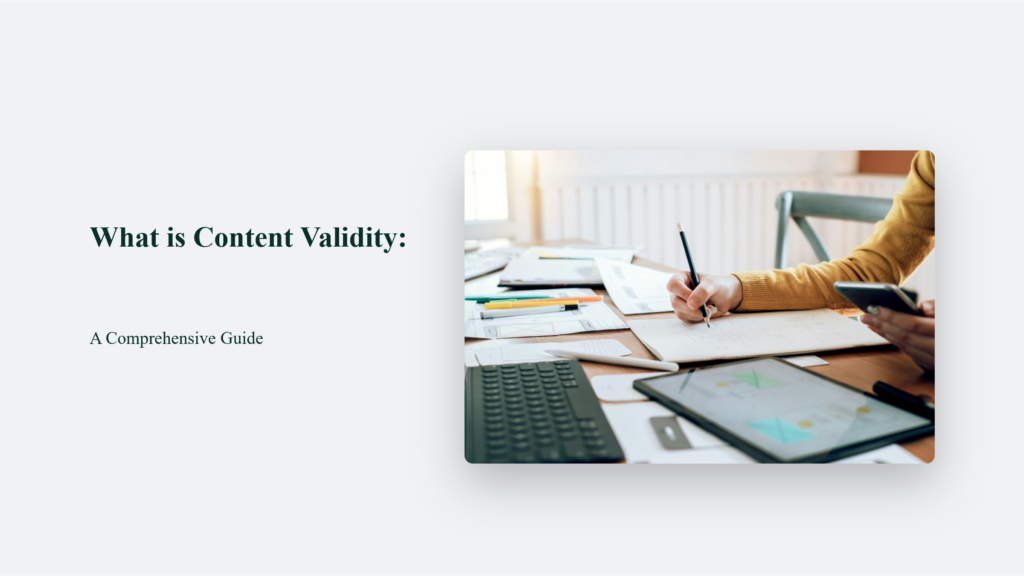Have you ever wondered what makes a piece of content truly valuable and effective? It’s not just about the words on the page or the website’s design. It’s about content validity. But what is content validity, and why is it so important? In this comprehensive guide, I’ll dive deep into content validity, exploring its definition, importance, and how you can ensure your content meets the highest standards.

What is Content Validity?
Content validity measures how well a piece of content represents the construct it aims to measure. In other words, it’s about ensuring that your content accurately and comprehensively covers the topic.
Think of it this way: if you’re creating a blog post about the benefits of yoga, your content should thoroughly discuss the physical, mental, and emotional benefits of the practice. Your content may lack validity if you only mention one or two benefits and fail to provide a comprehensive overview.
Why is Content Validity Important?
Content validity is crucial for several reasons:
- It ensures that your content is accurate and reliable. When your content is valid, readers can trust that your information is correct and based on sound research and expertise.
- It helps you meet your content goals. Whether you aim to educate, persuade, or entertain your audience, content validity ensures that your content is tailored to achieve those objectives.
- It enhances the user experience. Valid content is more engaging and valuable to readers as it clearly and comprehensively provides them with the necessary information.
- It boosts your credibility and authority. By consistently producing valid content, you establish yourself as a reliable and trustworthy source of information in your industry.
How to Ensure Content Validity
Now that we understand the importance of content validity let’s explore some best practices for ensuring your content meets the mark:
- Conduct thorough research. Before creating any piece of content, make sure to conduct extensive research on the topic. It includes gathering information from reputable sources, interviewing subject matter experts, and analyzing relevant data.
- Define your content goals. Clearly define what you want to achieve with your content, whether educating readers, driving conversions or building brand awareness. This will help you ensure that your content is tailored to meet those specific objectives.
- Use a comprehensive outline. Create a detailed outline that covers all the key points you want to address in your content. It will help ensure your content is comprehensive and includes all important information.
- Get feedback from your target audience. Before publishing your content, consider getting feedback from a sample of your target audience. It can help you gauge whether your content is relevant, engaging, and valuable to them.
- Collaborate with subject matter experts. If you’re creating content on a topic that requires specialized knowledge, consider collaborating with subject matter experts to ensure the accuracy and validity of your content.
- Use clear and concise language. Ensure your content is easy to read and understand, using clear and concise language appropriate for your target audience.
- Provide evidence to support your claims. When you make a claim or assertion in your content, provide evidence. It can include citing research studies, expert opinions, or real-world examples.
- Update your content regularly. As new information and research emerge, update your content to ensure it remains valid and relevant.
Measuring Content Validity
Measuring content validity can be challenging, as it’s not always straightforward. However, there are several methods you can use to assess the validity of your content:
- Expert review. Have subject matter experts review your content to ensure it accurately and comprehensively covers the topic.
- User testing. Conduct user testing with a sample of your target audience to gauge their understanding and engagement with your content.
- Analytics. Use web analytics tools to track metrics such as time on page, bounce rate, and conversion rates to assess how well your content resonates with your audience.
- Feedback surveys. Ask your audience for feedback on your content through surveys or feedback forms to gather insights on its relevance and value.
- Wintston AI: If you’re using AI to write, Winston AI content detection tool to helps check AI content generated with ChatGPT, GPT-4, Google Gemini and many more Large Language Models.
Final Thoughts:
Creating content with high validity is essential for building trust, authority, and engagement with your audience. By conducting thorough research, defining your content goals, and collaborating with subject matter experts, you can ensure that your content accurately and comprehensively covers the topic.
Remember, content validity is an ongoing process. As new information and research emerge, update your content regularly to ensure it remains relevant and valuable to your audience.
Do share this guide with your colleagues and friends if you find it helpful. Thank you for taking the time to read this comprehensive guide on content validity. By implementing these best practices and staying committed to creating high-quality, valid content, you’ll be well on your way to achieving your content goals and building a loyal, engaged audience.


![The ‘Giveaway Piggy Back Scam’ In Full Swing [2022]](https://www.cjco.com.au/wp-content/uploads/pexels-nataliya-vaitkevich-7172791-1-scaled-2-683x1024.jpg)

